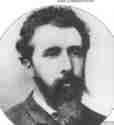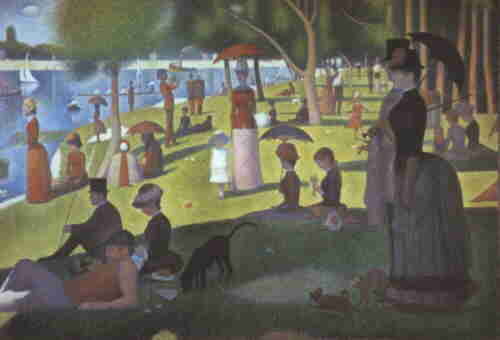 PART OF THE ARTSCHOOL
ONLINE NETWORK
PART OF THE ARTSCHOOL
ONLINE NETWORK
 THE
LIFE AND TIMES OF GEORGES SEURAT
THE
LIFE AND TIMES OF GEORGES SEURAT
THE QUIET EXPERIMENTER
Georges-Pierre Seurat was born in Paris on 2 December 1859,
the son of comfortably-off parents. His father, a legal official, was a
solitary man with a taciturn and withdrawn manner which his son also inherited.
At every available opportunity, Antoine-Chrisostome took leave of his family
and disappeared to his villa in the suburbs to grow flowers and say mass
in the company of his gardener; he was only at home on Tuesdays. Suerat's
mother was quiet and unassuming, but it was she who gave some warmth and
continuity to his childhood.
The family apartment was on the Boulevard de Magenta,
close to the landscaped pleasure garden the Parc des Buttes-Chaumont, where
young Georges and his mother spent much of their spare time. Such places,
and the people who frequented them, were to become the subject of some
of his greatest paintings.
THE HANDSOME STUDENT
As a young man Seurat was tall and handsome with "velvety
eyes" and a quiet, gentle voice. Reserved and dignified in dress as well
as manner, he was always neatly and correctly turned out: one friend described
him as looking like a floor-walker in a department store, while the sophisticated
and sharp-tongued Edgar Degas nicknamed him "the notary". He was serious
and intense - preferring to spend his money on books rather than on food
or drink - but his most pronounced characteristic was his secretiveness.
Despite many of the qualities of the perfect student,
Seurat did not particularly shine at school or at the Ecole des Beaux-Arts,
the official Paris art school, which he entered in 1878. But thanks to
a regular allowance, he never had any need to sell his work for a living
- nor to produce work that was salable. In 1879, a year of military service
broke into his artistic studies. Seurat was sent to the great military
port of Brest on the western coast of Brittany, where he fitted in easily
to barracks discipline and used his spare time to begin sketching figures
and ships.
Returning to Paris in 1880, the young artist initially
shared a cramped studio on the Left Bank with two student friends before
moving to a studio of his own, closer to his parent's home on the Right
Bank. For the next two years, he devoted himself to mastering the art of
black and white drawing.
 The
year 1883 was spent on a huge canvas, Bathing at Asnieres (left),
his first major painting. In 1884, the Salon jury rejected it and Seurat
changed the direction of his career. From this year on, he scorned the
academic art of the Salon and allied himself with the young independent
painters.
The
year 1883 was spent on a huge canvas, Bathing at Asnieres (left),
his first major painting. In 1884, the Salon jury rejected it and Seurat
changed the direction of his career. From this year on, he scorned the
academic art of the Salon and allied himself with the young independent
painters.
An instinctively gifted painter, Seurat also had extraordinary
powers of concentration and perseverance, and took a dogged and single-minded
approach to his work. He was convinced of the rightness of his own opinions,
and of the importance of the "pointillist" method he was developing. Although
other painters turned to him as a leader, he seems to have inspired admiration
rather than affection. He in turn looked upon this admiration as naturally
befitting his superior intellect, hard work and achievement.
MEMBER OF THE COMMITTEE
In May and June 1884, Suerat's Bathing at Asnieres
hung at the first exhibition of the new group of Artistes Independents,
mounted in a temporary hut near the ruined Tuileries Palace. The show ended
in financial muddle, but out of the ensuing arguments a properly constituted
Societe des Artistes Independents emerged, committed to holding an annual
show with no jury. Seurat attended its committee meetings regularly, always
sitting in the same seat, quietly smoking his pipe.
At one such meeting, Seurat struck up a friendship with
Paul Signac. Signac was four years younger, a largely self-taught painter
who was influenced by the Impressionists and very receptive to Seurat's
theoretical ideas. The extrovert and enthusiastic Signac provided Seurat
with contact and moral support as he set about making his mark within the
avant-garde.
In the summer of 1884, Seurat embarked on another major
canvas, again depicting the popular boating place of Asnieres, but this
time focusing on the island of La Grande Jatte in the Seine. With characteristic
single-mindedness, he devoted his time entirely to the composition. Every
day for months he traveled to his chosen spot, where he would work all
morning. Each afternoon, he continued painting the giant canvas in his
studio.
 After
two years of concentrated, systematic work, Seurat completed the painting
in 1886, and exhibited it with the Impressionist group in May of that year.
La Grand Jatte (left) proved to be the main talking point of the
exhibition, and he was hailed by the critics as offering the most significant
way forward from Impressionism.
After
two years of concentrated, systematic work, Seurat completed the painting
in 1886, and exhibited it with the Impressionist group in May of that year.
La Grand Jatte (left) proved to be the main talking point of the
exhibition, and he was hailed by the critics as offering the most significant
way forward from Impressionism.
Felix Feneon, a sensitive and sympathetic young critic,
was particularly impressed. He christened Seurat and his associates the
Neo-Impressionists, and became an enthusiastic spokesman for them. In a
series of articles on contemporary art in the newly launched Vogue
magazine, Feneon paid special attention to Seurat's work, and expounded
his new method in scientific detail.
CENTER OF CONTROVERSY
Suddenly, Seurat found that he was the most controversial
figure on the artistic scene in Paris. He was now occupying a studio next
to Signac's on the Boulevard de Clichy in Montmartre. Here he was surrounded
by artists ranging from the conservative decorator Puvis de Chavannes,
whom he greatly admired, to more progressive contempories - including Degas,
Gauguin, Van Gogh and Toulouse-Lautrec. He was at the center of artistic
debates, but he kept aloof from them.
Seurat's relative financial ease meant that he was unused
to dealing with potential clients, and his demands remained modest despite
his new fame. Once, when pressed to name his price for the painting he
was showing at "The Twenty" exhibition in Brussels, Seurat replied, "I
compute my expenses on the basis of one year at seven francs a day". His
attitude to his work was similarly down-to-earth and unromantic - he had
no pretensions to the status of genius. When some critics tried to describe
his work as poetic he contradicted them: "No, I apply my method and that
is all". He was, however, very concerned not to lose any credit for the
originality of his technique and guarded the details obsessively.
Seurat's life had begun to assume a regular pattern.
During the winter months, he would lock himself away in his studio working
on a big figure picture to exhibit in the spring, then he would spend the
summer months in one of the Normandy ports such as Honfleur, working on
smaller, less complex, marine paintings. Whether in Paris or at the coast,
Seurat was never a great socializer and in the last year of his life he
virtually cut himself off from friends. He could warm up in a one-on-one
situation, but by all accounts his conversation centered on his own artistic
concerns.
A SECRET FAMILY
Late in 1889, when Seurat was approaching 30, he moved away
from the bustling Boulevard de Clichy to a studio in a quieter street nearby,
where - unbeknown to his family and friends - he lived with a young model,
Madeleine Knobloch. In February 1890 she gave birth, in the studio, to
his son. Seurat legally acknowledged the child and gave him his own Christian
names in reverse. But it was not until two days before his death that he
introduced his young family to his mother.

Georges Seurat died in March 1891, totally unexpectedly:
he seems to have contracted a form of meningitis. One week he was helping
to hang the paintings at the Independents exhibition and worrying about
the fact that his hero Puvis de Chavannes had walked past The Circus
(below) without so much as a glance; the following week he was dead at
just 31 years of age. Signac sadly concluded "our poor friend killed himself
by overwork".
SEURAT GALLERY
BACK TO START PAGE
 THE
LIFE AND TIMES OF GEORGES SEURAT
THE
LIFE AND TIMES OF GEORGES SEURAT
 The
year 1883 was spent on a huge canvas, Bathing at Asnieres (left),
his first major painting. In 1884, the Salon jury rejected it and Seurat
changed the direction of his career. From this year on, he scorned the
academic art of the Salon and allied himself with the young independent
painters.
The
year 1883 was spent on a huge canvas, Bathing at Asnieres (left),
his first major painting. In 1884, the Salon jury rejected it and Seurat
changed the direction of his career. From this year on, he scorned the
academic art of the Salon and allied himself with the young independent
painters.
 After
two years of concentrated, systematic work, Seurat completed the painting
in 1886, and exhibited it with the Impressionist group in May of that year.
La Grand Jatte (left) proved to be the main talking point of the
exhibition, and he was hailed by the critics as offering the most significant
way forward from Impressionism.
After
two years of concentrated, systematic work, Seurat completed the painting
in 1886, and exhibited it with the Impressionist group in May of that year.
La Grand Jatte (left) proved to be the main talking point of the
exhibition, and he was hailed by the critics as offering the most significant
way forward from Impressionism.
